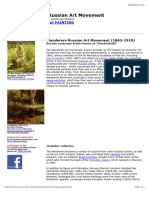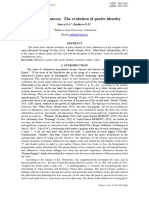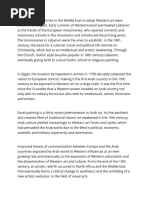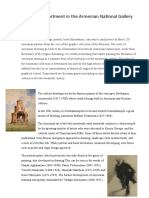Ukraine
Ukraine
Uploaded by
Олінька СтецюкCopyright:
Available Formats
Ukraine
Ukraine
Uploaded by
Олінька СтецюкOriginal Title
Copyright
Available Formats
Share this document
Did you find this document useful?
Is this content inappropriate?
Copyright:
Available Formats
Ukraine
Ukraine
Uploaded by
Олінька СтецюкCopyright:
Available Formats
Painting in Ukraine
In the 15th and 16th centuries there emerged a Galician school of icon painting, in
which adherence to Byzantine iconography was tempered by personal interpretations,
individual variations, and Western influences. During the Renaissance icons
gradually lost their rigidity and became more realistic. The 17th century introduced
secular themes, three-dimensional forms and movement in icons.
In Ukraine portrait painting as a separate genre emerged during the Renaissance
and was strongly influenced by the icon tradition. The first portraits were those of
benefactors which were hung in churches. Portraits which were not used for religious
purposes did not emerge until the 17th century. They included official portrayals of
nobles and Cossack hetmans and officers, as well as more intimate portraits of nobles
and townspeople.
Academy of Arts in St. Petersburg was established in 1757 and it attracted
Ukrainian artists greatly. Among those who continued to pursue their careers in
Ukraine was Taras Shevchenko (1814-1861). He devoted most of his painting to
Ukrainian interests. All the works executed by him can be divided into three groups:
portraits and self-portraits, landscape paintings of Ukraine, Kazakhstan, the Aral Sea,
and genre compositions. Shevchenko’s professional skills, a faithful depiction of the
model combined with deep penetration into man’s inner world are characteristic
features of Shevchenko’s water colour portraits (“Portrait of an Unknown”, “Portrait
of N. Lunin”, “Portrait of M. Sokolovsky”, “Katya, the Kazakh girl”). Genre
compositions “Kateryna” and “Gypsy Fortune-Teller” (the latter was awarded a silver
medal by the Academy of Arts) were cast by his own poems.
During the 19th century landscape painting appeared as a separate genre and not
only in the works of T. Shevchenko. Inspired by romanticism I. Sochenko, A
.Kuindzhi, and S. Vasylkivsky recorded the pastoral setting of rural scenery while I.
Aivasovsky devoted his efforts to depicting the beauty of the sea.
The creative work of the prominent Ukrainian artist of the late 19th – early 20th
centuries, Mykola Pimonenko (1862-1912) occupies a place of note in Ukrainian
genre painting. A number of M. Pimonenko’s paintings are generalized portraits
which embody a popular ideal of a working man (“A Young Woman”, “A Reaper”).
The artist also turned to the theme of peasant labour depicting typical themes from
everyday life against the backdrop of a landscape (“Harvest-Time”, “A Ploughman”,
“Haymaking in Ukraine”).
The 20th century avant-garde movement had a direct impact on Ukrainian
painting. Artists born in Ukraine as well as those who considered themselves
Ukrainian by nationality were in its vanguard. The most prominent of them were K.
Malevich, A. Ekster, V. Tatlin who introduced suprematism, futurism and cubism into
Ukrainian painting. But in the 1930s avant-garde movement came to a halt with
introduction of social realism as the only artistic method permitted by the communist
regime. Paintings were limited to portraits of leaders and genre compositions of
happy workers and peasants.
Among those who joined social realism but added much of their own were
Kateryna Bilokur and Tetyana Yablonska. Kateryna Bilokur (1900-1961) is a highly
original Ukrainian folk artist. Her beautiful pictures of the colourful Ukrainian nature
are a significant landmark in the history of Ukrainian folk art. Bilokur’s first works
were amateurish. They were the portraits of her relatives and villagers executed with
charcoal and self-made vegetable paints. Then she took to drawing still lives and
flower pieces. Skill of selecting subject matter, vitality, fanciful composition and
harmony of colours are characteristics of these pictures and have become the main
features of all the work of the artist. Such original works as “Apples and Tomatoes”,
“Breakfast”, “Watermelon, Carrots and Flowers”, “Flowers and Grapes” are
distinguished for their freshness and verve.
The famous Ukrainian painter Tetyana Yablonska (1917-2005) established herself
as an original and outstanding artist. She became the leader of many young Ukrainian
artists in pursuit of new styles and it is this thirst for novel imaginary and plastic
means which makes her work fresh and consistent with time. Yablonska’s artistic
manner was evident even in the sketches such as “Woman with a Yoke” and
“Milkmaid” as well as in the unfinished canvas “Wedding On the Collective Farm”.
The year 1949 saw the appearance of Yablonska’s renowned canvas “Grain” which
made her famous as a first-grade painter and proved a milestone in the Soviet visual
art. The topics of her work embrace various subjects: peace and work, the happiness
of motherhood, the wisdom of old people, Man with his sorrows and joys. Half a
century ago Yablonska’s pictures catapulted her to worldwide fame. Critics still like
to draw literary parallels to her pictures. For example, they called “Bread” “the novel
of a picture,” while the canvas “Morning”, showing a girl against the backdrop of an
open window, is associated with a “poem,” and “A People’s Poem”, which depicts
life in the Ukrainian countryside, is “a people’s epic.” Her pictures resemble haiku.
Like Japanese miniatures, her canvases show an event which occurs in nature and is
valuable in itself, for example, wandering clouds or a sunset as a sign of an immortal
life and eternity.
Nowadays Ukrainian artists are free to follow any style of painting and we can
observe a mixture of different styles in their works.
You might also like
- Aleksandr Deineka (1899-1969) - An Avant-Garde For The ProletariatDocument456 pagesAleksandr Deineka (1899-1969) - An Avant-Garde For The ProletariatSebastián ZamudioNo ratings yet
- Foreign Policy National Interest and DiplomacyDocument4 pagesForeign Policy National Interest and Diplomacyhizbullah chandio0% (1)
- Outstanding Ukranian ArtistsDocument9 pagesOutstanding Ukranian Artistsleraloza73No ratings yet
- Ilia RepinDocument28 pagesIlia RepinKaterine Cortes RiosNo ratings yet
- Fedot Vasilevich Sychkov (Russian: Федот Васильевич Сычков), March 13,Document4 pagesFedot Vasilevich Sychkov (Russian: Федот Васильевич Сычков), March 13,paulina R.No ratings yet
- Brochure For 'The Art of Feodosiy Humeniuk'Document2 pagesBrochure For 'The Art of Feodosiy Humeniuk'LukaszCudnyNo ratings yet
- ShevchenkoDocument11 pagesShevchenkoОКСАНА УХНАЛЁВАNo ratings yet
- Russ 10693Document58 pagesRuss 10693MonaLupescu100% (1)
- Myroslav Shkandrij - Avant-Garde Art in Ukraine, 1910-1930 - Contested Memory-Academic Studies Press (2019)Document202 pagesMyroslav Shkandrij - Avant-Garde Art in Ukraine, 1910-1930 - Contested Memory-Academic Studies Press (2019)Niko HeinonenNo ratings yet
- Aleksandr Deineka 1899-1969 An Avant-Garde For The Proletariat 2011 PDFDocument456 pagesAleksandr Deineka 1899-1969 An Avant-Garde For The Proletariat 2011 PDFSebastiao Brandao MiguelNo ratings yet
- Mykola Tereshchenko's Translation LegacyDocument12 pagesMykola Tereshchenko's Translation LegacyМаша ХандогаNo ratings yet
- WitkacyDocument3 pagesWitkacyPaulina LipińskaNo ratings yet
- Taras Hryhorovych ShevchenkoDocument10 pagesTaras Hryhorovych ShevchenkoVolker IsalasinoNo ratings yet
- Wanderers: Russian Landscape Artists: PeredvizhnikiDocument2 pagesWanderers: Russian Landscape Artists: PeredvizhnikiAlly DeanNo ratings yet
- The Russian ItinerantsDocument42 pagesThe Russian ItinerantsGuzel AbdrakhmanovaNo ratings yet
- Futurist Poets and PaintersDocument12 pagesFuturist Poets and PaintersZdenko MandušićNo ratings yet
- Dmitry Mitrohin - DisquisitionDocument6 pagesDmitry Mitrohin - DisquisitionJennifer AdvientoNo ratings yet
- Vocal Performance 234 QuizDocument1 pageVocal Performance 234 QuizSaith sabNo ratings yet
- WitkacyDocument3 pagesWitkacyPaulina LipińskaNo ratings yet
- The Evolution of Poetic IdentityDocument5 pagesThe Evolution of Poetic IdentityresearchparksNo ratings yet
- The Russian - Orthodox Icon Painting and Its Repercussions On The Russian Art of The 20th CenturyDocument12 pagesThe Russian - Orthodox Icon Painting and Its Repercussions On The Russian Art of The 20th CenturyIsik Eflan TINAZ100% (1)
- Polish Female Composers in the Nineteenth CenturyDocument12 pagesPolish Female Composers in the Nineteenth CenturyfoxcurverNo ratings yet
- KHACHATURIAN Adagio From SpartacusDocument1 pageKHACHATURIAN Adagio From Spartacusfarzad0% (1)
- Document 1Document5 pagesDocument 1casssmit05No ratings yet
- National Art Museum of UkraineDocument4 pagesNational Art Museum of UkraineNeolaNo ratings yet
- Kazimierz Stabrowski Esoteric Dimension PDFDocument26 pagesKazimierz Stabrowski Esoteric Dimension PDFMarioNo ratings yet
- Brilliant Ukrainian Artists (Shadko)Document7 pagesBrilliant Ukrainian Artists (Shadko)maksifon6No ratings yet
- Post-Stalinist Liberalization in Georgian PaintingDocument6 pagesPost-Stalinist Liberalization in Georgian PaintingGeorgian National MuseumNo ratings yet
- Clemena Antonova, How Modernity Invented Tradition PDFDocument7 pagesClemena Antonova, How Modernity Invented Tradition PDFLudovico Da FeltreNo ratings yet
- Circling The Square Avant-Garde Porcelain From Revolutionary RussiaDocument14 pagesCircling The Square Avant-Garde Porcelain From Revolutionary RussiaVormtaalNo ratings yet
- English Georgie NarbutDocument27 pagesEnglish Georgie Narbutgonharuk986No ratings yet
- The Icon As The Source of Primitivism inDocument38 pagesThe Icon As The Source of Primitivism inLucia NogueraNo ratings yet
- Silent Painting and Strict StyleDocument11 pagesSilent Painting and Strict StyleНаталя ДуткевичNo ratings yet
- Russia On Canvas, Ilya Repin, 0271002522, 1980, p1-88Document92 pagesRussia On Canvas, Ilya Repin, 0271002522, 1980, p1-88M3rri100% (2)
- Vasily Surikov, Russian History PainterDocument3 pagesVasily Surikov, Russian History PainterAlly DeanNo ratings yet
- About PeredvizhnikiDocument2 pagesAbout PeredvizhnikiVictor MalkovNo ratings yet
- Mikhail Vrubel - WikipediaDocument41 pagesMikhail Vrubel - WikipediaClaviusNo ratings yet
- Ivan Kramskoy: Russian Portrait Artist: BiographyDocument4 pagesIvan Kramskoy: Russian Portrait Artist: BiographyAlly DeanNo ratings yet
- The Pre-Raphaelite Journey Into The Middle AgesDocument15 pagesThe Pre-Raphaelite Journey Into The Middle Agesjoyce.voeglerNo ratings yet
- Alexei Von Jawlensky, Russian Expressionist PainterDocument4 pagesAlexei Von Jawlensky, Russian Expressionist PainterAlly DeanNo ratings yet
- Ciurlionis Eng Article ZukieneDocument15 pagesCiurlionis Eng Article ZukieneSquawNo ratings yet
- "Hands Off That Sacred Image!" The Vladimir Icon and Its PowerDocument80 pages"Hands Off That Sacred Image!" The Vladimir Icon and Its PowerRaluca Iuliana ButoiNo ratings yet
- Polish PhotographersDocument4 pagesPolish PhotographersDomi NikaNo ratings yet
- Jared Ash - Primitivism in Russian FuturismDocument8 pagesJared Ash - Primitivism in Russian FuturismGiovanni BelloNo ratings yet
- Boris Kustodiev PDFDocument5 pagesBoris Kustodiev PDFmarinomarcelo6614No ratings yet
- Russian Symbolism - Русский символизм. A compilation from en. and ru. WikipediaDocument106 pagesRussian Symbolism - Русский символизм. A compilation from en. and ru. WikipediaTatiana Polomochnykh100% (2)
- Notes For CiichDocument31 pagesNotes For Ciichzahraawb123No ratings yet
- Graphics Department in The Armenian National GalleryDocument3 pagesGraphics Department in The Armenian National GalleryqrisineNo ratings yet
- KandinskiDocument10 pagesKandinskimirunacarp777No ratings yet
- Lamps of Architecture (1849) and The Stones of Venice (Published in 3 VolumesDocument5 pagesLamps of Architecture (1849) and The Stones of Venice (Published in 3 VolumesiramNo ratings yet
- Elmira ShahtakhtinskayaDocument15 pagesElmira ShahtakhtinskayaInforma.azNo ratings yet
- пасажирDocument6 pagesпасажирОлінька СтецюкNo ratings yet
- Перелік екзаменаційних питаньDocument5 pagesПерелік екзаменаційних питаньОлінька СтецюкNo ratings yet
- Jean AitchiconDocument105 pagesJean AitchiconОлінька Стецюк100% (1)
- Phonetics And Phonology: (глоточна), and laryngeal (гортанна) cavities. The air passes from the lungs into the windpipe,Document7 pagesPhonetics And Phonology: (глоточна), and laryngeal (гортанна) cavities. The air passes from the lungs into the windpipe,Олінька СтецюкNo ratings yet
- Last Name First Name Date of Birth Sex Passport Details Visa DataDocument6 pagesLast Name First Name Date of Birth Sex Passport Details Visa DataОлінька СтецюкNo ratings yet
- Case With Mr. Robins: Read Books, Talked With Colleagues andDocument1 pageCase With Mr. Robins: Read Books, Talked With Colleagues andОлінька СтецюкNo ratings yet
- Shopping VocabularyDocument36 pagesShopping VocabularyОлінька СтецюкNo ratings yet
- Venice Film FestivalDocument13 pagesVenice Film FestivalОлінька СтецюкNo ratings yet
- Georg LucksDocument19 pagesGeorg LucksОлінька СтецюкNo ratings yet
- 4the Number of PassengersDocument6 pages4the Number of PassengersОлінька СтецюкNo ratings yet
- Traveling by PlaneDocument1 pageTraveling by PlaneОлінька СтецюкNo ratings yet
- Traveling by TrainDocument1 pageTraveling by TrainОлінька СтецюкNo ratings yet
- The Infant Samuel Admiral Hood: TH THDocument3 pagesThe Infant Samuel Admiral Hood: TH THОлінька СтецюкNo ratings yet
- Lumiere Showed Several Short Films. They Were All Documentaries and One of ThemDocument2 pagesLumiere Showed Several Short Films. They Were All Documentaries and One of ThemОлінька СтецюкNo ratings yet
- Painting in AmericaDocument2 pagesPainting in AmericaОлінька СтецюкNo ratings yet
- he Out: Could Answer TH - MDocument3 pageshe Out: Could Answer TH - MОлінька СтецюкNo ratings yet
- General Features: Zinziura Olga Group 63Document13 pagesGeneral Features: Zinziura Olga Group 63Олінька СтецюкNo ratings yet
- Past Continuous Worksheet Affirmative1 PDFDocument5 pagesPast Continuous Worksheet Affirmative1 PDFОлінька Стецюк100% (2)
- АртикльDocument3 pagesАртикльОлінька СтецюкNo ratings yet
- Cuadernillos Matematicas 1 SantillanaDocument1 pageCuadernillos Matematicas 1 SantillanaCarolina AhumadaNo ratings yet
- Mae SyllabusDocument113 pagesMae SyllabusPrashant ChawlaNo ratings yet
- Handbook 2009 2010Document168 pagesHandbook 2009 2010Donovan UwiRugby Jackson100% (1)
- Mwawasi - Factors Influencing Occupational Health and Safety Practices in The Private Hospitals in Mombasa Island PDFDocument77 pagesMwawasi - Factors Influencing Occupational Health and Safety Practices in The Private Hospitals in Mombasa Island PDFTamikNo ratings yet
- Commonwealth of Massachusetts The Trial Court Middlesex Superior CourtDocument15 pagesCommonwealth of Massachusetts The Trial Court Middlesex Superior CourtMohan HariharNo ratings yet
- Arieyanti Dwi Astuti Badan Perencanaan Pembangunan Daerah Kabupaten Pati Jl. Raya Pati-Kudus Km. 4 Pati. 59163. Jawa TengahDocument15 pagesArieyanti Dwi Astuti Badan Perencanaan Pembangunan Daerah Kabupaten Pati Jl. Raya Pati-Kudus Km. 4 Pati. 59163. Jawa TengahFitriani 1310No ratings yet
- Membform Occupational Group EngineerDocument2 pagesMembform Occupational Group EngineerOppong Appiah AndrewsNo ratings yet
- Delhi Technological University: Formerly Delhi College of EngineeringDocument1 pageDelhi Technological University: Formerly Delhi College of Engineeringdoeselephant hNo ratings yet
- Central Bank Employees Association V BSP 2004 DigestDocument2 pagesCentral Bank Employees Association V BSP 2004 DigestJulia Alexandra ChuNo ratings yet
- Impairment and Disability-1Document22 pagesImpairment and Disability-1Regina PunNo ratings yet
- Purchasing Portfolio ModelDocument25 pagesPurchasing Portfolio ModelFrido Wilbard100% (2)
- Application Form SEMPHILDocument3 pagesApplication Form SEMPHILDeanne Reyes75% (4)
- Case Digest CrimlawDocument3 pagesCase Digest CrimlawchristineNo ratings yet
- Unit-12: Consumer Protection: (A) Match The Column Type QuestionsDocument3 pagesUnit-12: Consumer Protection: (A) Match The Column Type QuestionsRaghavNo ratings yet
- Discussion and Position Paper - RizalDocument22 pagesDiscussion and Position Paper - Rizalczedie57% (7)
- Portfolio Day Accomplishment ReportDocument1 pagePortfolio Day Accomplishment ReportLorelyn Buscagan Elivera100% (10)
- Passport ECNR FormDocument3 pagesPassport ECNR Formapi-374850680% (5)
- Kajian Sikap Dan Persepsi Terhadap Pembelajaran Bahasa Mandarin Dalam Kalangan Pelajar Uitm KelantanDocument16 pagesKajian Sikap Dan Persepsi Terhadap Pembelajaran Bahasa Mandarin Dalam Kalangan Pelajar Uitm KelantanayuNo ratings yet
- DLPDocument3 pagesDLPMyline Ejorcadas RealNo ratings yet
- Saint Orlan: Ritual As Violent Spectacle and Cultural CriticismDocument8 pagesSaint Orlan: Ritual As Violent Spectacle and Cultural CriticismserluloNo ratings yet
- Christopher Alexander's Design Theory From Notes oDocument10 pagesChristopher Alexander's Design Theory From Notes oStanley LimaNo ratings yet
- Scheduling Resources and CostsDocument42 pagesScheduling Resources and CostsRajesh SinghNo ratings yet
- RFP For Bio Metric Deivce & SSO SoftwareDocument29 pagesRFP For Bio Metric Deivce & SSO SoftwareAnonymous mRCnYKz7xBNo ratings yet
- The Difference Between Precepting and MentoringDocument1 pageThe Difference Between Precepting and MentoringAmeng GosimNo ratings yet
- Conflict & Conflict ManagementDocument19 pagesConflict & Conflict ManagementRoszelan MajidNo ratings yet
- MGT 314, Fall-2019 Section:17 Assignment On: Meshbaul Hassan ChowdhuryDocument7 pagesMGT 314, Fall-2019 Section:17 Assignment On: Meshbaul Hassan ChowdhuryRashaduzzaman RiadNo ratings yet
- Remote Lab For Robotics Applications: Abstract-This Article Describes The Development of A Remote Lab EnvironDocument8 pagesRemote Lab For Robotics Applications: Abstract-This Article Describes The Development of A Remote Lab Environagusriki3440No ratings yet
- Constitution of Zambia, 1991 (Amended To 1996)Document135 pagesConstitution of Zambia, 1991 (Amended To 1996)Chola Mukanga100% (2)
- An Analysis of Figurative Language Used in BrunoDocument7 pagesAn Analysis of Figurative Language Used in BrunoogikNo ratings yet












































































































